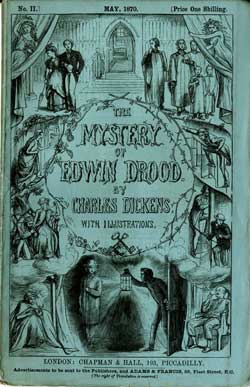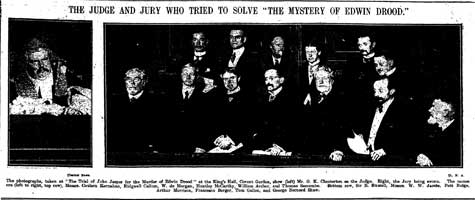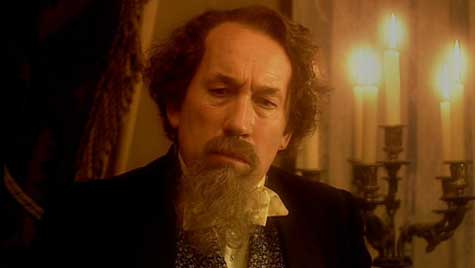 On June 8, 1870, in the middle of composing the twelve part serial The Mystery of Edwin Drood, the story came to a jarring standstill when, after a long day's work on what would become his last set of characters, Charles Dickens suffered a stroke and passed away the following day. Chapman & Hall went on to publish the six installments that had been completed, leaving Drood, John Jasper, Rosa Bud, and company to wander about an endless stage with no curtain call. And even now, 145 years after the beguiling mystery of what happened to Edwin Drood first took hold, it shows no signs of letting up.
On June 8, 1870, in the middle of composing the twelve part serial The Mystery of Edwin Drood, the story came to a jarring standstill when, after a long day's work on what would become his last set of characters, Charles Dickens suffered a stroke and passed away the following day. Chapman & Hall went on to publish the six installments that had been completed, leaving Drood, John Jasper, Rosa Bud, and company to wander about an endless stage with no curtain call. And even now, 145 years after the beguiling mystery of what happened to Edwin Drood first took hold, it shows no signs of letting up.
His last tale returns to a familiar theme for Dickens and that is one of orphans—or in the case here, four orphans, beginning with Edwin Drood and Rosa Bud. Their parents had been friends and wished for their kids to get hitched. Edwin and Rosa have decided they have no interest in becoming betrothed but keep it quiet as not to cause a scandal. That also gives Rosa time to find out if she will lose her inheritance if she doesn’t wed Edwin as dictated. Enter the second set of orphans: Neville and Helena Landless. Neville is instantly smitten with Rosa, and Helena and Rosa develop a strong bond as best friends. Neville doesn’t much care for Edwin’s less than gentlemanly manner with Rosa and becomes an instant foe.
Then there’s the towering figure in this Victorian soap opera and the real protagonist of the novel, John Jasper, a choirmaster of the Cloisterham Cathedral where he teaches music to Rosa and is Drood’s uncle and guardian. He also has been secretly in love with Rosa for years and, like Neville, doesn’t think Edwin is good enough. Unfortunate for Jasper, Rosa finds him creepy and has zero interest in return.

These are the main tributaries flowing before Drood vanishes, leaving nothing but his watch and chain plus a shirt pin alongside a river weir. What happened was unexpectedly truncated with the author’s death. Several film, stage, and TV adaptations have offered different scenarios as to the conclusion. One of the most notable assemblies occurred in 1914 when The Dickens Fellowship held a mock trial with playwright George Bernard Shaw as a jury foreman and G.K. Chesterson (of Father Brown mysteries fame) as the judge and a charge of manslaughter was handed down in the largely fun-filled proceedings. The award for one of the most creative renderings goes to BBC’s Doctor Who that imagined the ninth incarnation of the Time Lord (Christopher Eccleston) and companion Rose Tyler (Billie Piper) meeting Charles Dickens (The Doctor lets Charles know he’s his number one fan) in 1869 where they investigate alien gas creatures called the Gelth. The author, inspired, states that the final novel will be called The Mystery of Edwin Drood and the Blue Elementals and Drood’s murderer is no longer the uncle.

One reason for the continuing unrest in Drood Land is not just because it was disrupted half-finished, but because a majority of readers are not satisfied with the thought that Jasper killed his nephew. Too simple and contrite though a modern twist proposes that Jasper was a split personality which certainly helps that motive along. Still, why would Dickens have all these threads including Neville’s love pangs for Rosa to just go with the obvious? Yes, in an outline to his editor, Dickens said he would pin the murder on the hapless Jasper but, perhaps, that was a preliminary caution to ward off any possible leaks. After all, Dickens was the J.K. Rowling of his time and interest in anything he wrote ran high. A red herring? And, if so, he doubled down since according to Wikipedia, the illustrator of the serial, Luke Fildes, was told by Dickens, “I must have the double necktie! It is necessary, for Jasper strangles Edwin Drood with it.”
So what are your thoughts? Did Jasper kill Edwin? How about Neville? Or did Edwin live and simply move somewhere else which has also been put forward … remember, dear Sherlockians, no body was found. Or maybe one of the other sixteen Dickensian characters packed into Edwin Drood had a hand. Many, many questions abound and that’s the beauty of The Mystery of Edwin Drood.
Edward A. Grainger aka David Cranmer is the editor/publisher of the BEAT to a PULP webzine and books and the recent anthology collection, The Lizard’s Ardent Uniform and Other Stories.
Read all of Edward A. Grainger's posts for Criminal Element.

A transcript of the mock trial would be interesting. I’ve never got far enough along in reading Dickens to get to Drood. From your excellent post I assume the disappearance may never get solved.
If you take Dickens at face value (I believe that’s the right expression here) then Drood’s uncle is the culprit. I along with quite a few others choose to believe otherwise.
The Enduring Riddle of Edwin Drord is a novel written by Charles Dickens. This mystery novel is set in a Gothic church and tells the story of a young boy named “Edwin” who goes missing and is never seen again. The author is known as David Cranmer, and is also the author of BEAT to a PULP and The Lizard’s Ardent Uniform and Other Stories.
I am a college student in Alabama and have come to the conclusion that it is better to buy a dissertation online rather than spend time on it yourself. Especially if you don’t know how to do it. I turned to professional writers who are ready to help me with this, on time and without plagiarism